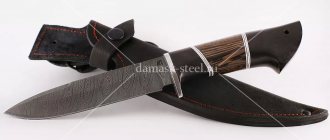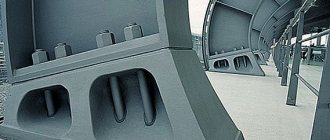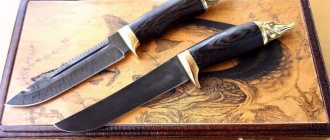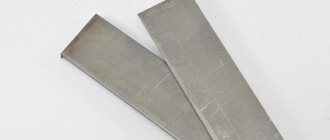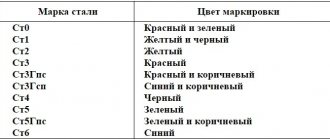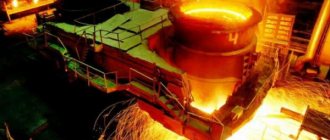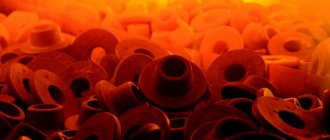What is damask steel and what is Damascus: differences between steels
To bring non-specialists up to speed, let's look at these two types of patterned steels separately. So:
Damascus
The translation of the word "Damascus" from Arabic sounds like water. This is due to the fact that blades made of high-quality Damascus resemble the surface of rippling water. This explanation is one of several options for the origin of the name of this metal. In essence, it is a package of steels of various grades, repeatedly forged by forging. The number of layers of modern Damascus can reach 150, 300, 600 or more.
Bulat
The smelting of modern damask steel is carried out by many workshops, and the result of their work is often difficult to attribute to damask steel. This article deals only with damask steel produced in the workshop of Sergei Baranov. The technology for producing this metal is based on archival workbooks of the great Russian metallurgist Pavel Petrovich Anosov. It was he who, in the 30s of the 19th century, received the first Russian damask steel, which was in no way inferior to the legendary patterned metal of antiquity.
Sergei Baranov's cast damask steel is obtained as a result of crucible remelting of a charge consisting of a mixture of special additives and steel grades: EI-107 and Kh12MF. Complex technology of long-term melting, special cooling and heat treatment methods make it possible to give the blades high hardness.
| Damask steel knife | Damascus steel knife |
Advantages and disadvantages
The special properties of Damascus steel, a kind of saw along the edge of the cutting edge, are a consequence of the presence of soft and hard grades of steel in the package. Depending on the original composition of the package, Damascus can be corroded or weather-resistant. Typically their Damascus blades have a hardness of 57-59 HRC.
The special properties of damask steel are high hardness combined with viscosity and strength. A damask knife with a hardness of 62-64 HRC has a strong cutting edge that is not prone to chipping. In addition, Baranov’s damask steel is not subject to corrosion.
How to sharpen a Damascus steel knife
To sharpen a Damascus knife with your own hands, you need to consider the following nuances:
- part of the blade with nicks and chips needs to be cut down for alignment;
- sharpening the knife is done slowly and carefully so that one layer of the layered structure does not bend onto another - for this, abrasive materials with successively decreasing grain size are used;
- sharpening is carried out diagonally - sharpening the blade lengthwise is ineffective;
- sharpening grooves and stripes spoil the design of the product - they need to be polished with a fine-grained material;
- The sharpened knife must be wiped with a napkin; you can use lemon zest.
Sharpening a knife made of pre-Mas steel.
Choosing steel for a knife
I will try to give you only the necessary knowledge that you need to rely on when choosing steel for a knife. I will omit the chemical compositions of steels and some technical characteristics. You don’t need to know them; manufacturers need to know them. In any case, you can easily find this information on the Internet.
Each blade must have certain user characteristics, so we need to pay attention to them. I gave each steel a rating on a 10-point scale in terms of these characteristics (hardness, strength, etc.) The result: the higher the rating, the better the steel in my opinion.
Determining the best steel for a knife
So, having determined each steel its rating on my scale, the following comes out:
1st place - Knives made of steel S390. In principle, this is predictable, since S390 is a powder metal, and powder metallurgy has stepped far forward. In terms of three most important consumer indicators, this metal is unrivaled. The only disadvantage of this steel is the high PRICE, which is due to the complexity of manufacturing and the Euro exchange rate, since the metal is imported.
2nd - 3rd place was shared by Damask steel knives and M390 steel. It’s very interesting here; for gourmets and connoisseurs, I would recommend Bulat steel, but for beginners and practical people, M390 steel. This is due to the fact that damask steel is a little longer and cuts better, and the M390 does not require maintenance. In any case, you will not see the difference in these metals on “one moose”. As my friend said, “It’s hunting season,” maybe you’ll understand.
See the table for further locations, but I would like to add:
Elmax is a cool metal, when we first got it (about a couple of years ago) I, as always, took it for tests, hunting, fishing, building a house. To be honest, I still have that knife to this day.
Knives made of x12MF steel and Damascus steel - there is no need to say anything about these knives if I took into account such an indicator as price in my rating. These metals would be in 1st and 2nd place respectively.
Knives made of steel 65x13 and 95x18 are the two steels that were used in the manufacture of knives in Soviet times. One is rolled steel, the other is forged, both are stainless. So these knives are still in use today, especially those with the “Cockerel”. A distinctive feature of these metals is the possibility of sharpening in the field.
This article is my personal opinion, I do not impose it on anyone and do not claim to be 100% true. This is just the experience of my 10 years of work in knife production. Best regards, Dmitry.
Video testing of knives
Source
History[edit | edit code]
Refined steel was used almost immediately after people mastered the process of making cast iron, since the product of a cheese furnace in its pure form was unsuitable for dressing. Around 1300 BC e. corresponding technology appeared in Western Asia, around 800 BC. e. penetrated into Europe, and in China, archaeologists proved the independent reduction of ore using a cheese furnace around the 7th-6th centuries BC. e. The welding of different types of steel and the targeted production of welded damascus have been developed in most cases independently of each other. Already in the first centuries BC. e. similar materials were known in both Europe and China. There is information[2] that in the 3rd century AD. e. The Romans already knew weapons made of Damascus steel. The Nydam find[2] contains many swords with very complex welding along with blades that are much simpler in construction.[3]
Indian crucible steel was first mentioned around 300 BC. e.[4] Damascus came to Iran in the 6th century. On the territory of Kievan Rus, patterned damask steel was known, although rare, even in the pre-Mongol period and was called damask steel or “red iron”. The use of Damascus weapons in Rus' reached a more significant scale only in the 15th century, but until the beginning of the 18th century, a few Damascus and damask blades were imported from Persia. There is no information about the local production of Damascus and damask steels, but there is information about their import. In pre-Mongol Rus', welded kharalug was known,[5] the manufacturing technology of which was lost and restored only at the end of the 20th century. The first mention of this technology can be considered information from Al-Biruni:[6]
The Rus made their swords from, and the fullers in the middle of them from, in order to give them strength upon impact and prevent their fragility. cannot stand the cold of their winters and breaks upon impact. When they became acquainted with , they invented wickerwork for dols from long wires (made) from both types of iron - and. And they began to get amazing and rare things from the welded weaves when immersed (in the etchant), the kind that they wanted and intended to get. but it does not turn out according to the intention during production and does not come at will, but it is accidental.
And “Kharalug” is mentioned in “The Tale of Igor’s Campaign.”
Yar round Vsevolod! you stand on the harrow, you prick your arms with arrows, you rattle your swords against your helmets.
At the same time, there is no unambiguous interpretation of the term “kharalug”.
Welding Damascus[edit | edit code]
By combining steel blanks with different carbon contents, followed by welding, folding and forging, blacksmiths controlled the properties of the resulting material. Iron, as a rule, is soft and easily deformed, while high-carbon steel is hard and (with proper heat treatment) elastic. By combining iron and high-carbon steel, a material was obtained that compensated for the shortcomings of both original steels. This resulted in alternating layers of metal with very high and very low carbon content. The former acquired greater hardness during hardening, while the latter, on the contrary, were not hardened at all and served as a shock-absorbing substrate. Soft iron layers prevented the metal from being too brittle, and high-carbon layers gave the necessary elasticity and sharpness. Carbon diffusion also averaged to some extent its distribution in the workpiece.
The main and important disadvantage of Damascus steel is its low corrosion resistance, due to the high carbon content in the forging components and the almost complete absence of alloying elements.
Using a more advanced technique, adopted in Arab countries, early medieval Europe or China, a bundle of pre-prepared wire or tape with a certain carbon content was forged. This way, less time and hardware was wasted. Already in the 3rd century BC. e., according to archaeological finds, the European Celts made welded damasks. In the first centuries of our era, the so-called twisted haralug came into fashion; bars of dissimilar steels were welded, twisted into a spiral, forged again and joined together with the same blanks into one bar. A large number of German, late Roman and Frankish swords older than the 10th century that have survived to this day have complex damask damask.
The patterns on the surface of this type of damascus are the optical effect of the uneven distribution of carbon due to the heterogeneity of the material. This effect was often enhanced by special polishing methods and etching the surface with acids. The pattern itself is not initially the main purpose of making welded kharalugs, but just a side effect.
Choosing a hunting knife
Currently, there are many different types of knives, differing in shape, size, material, type and purpose.
Choosing a truly good blade is not as easy as it seems at first glance, since the range of such products is quite large. If you want to buy a high-quality knife for hunting, and not just a beautiful souvenir, then pay attention to the material of the handle, shape, design, and also an important factor is the steel of the blade.
Choosing steel for a hunting knife
When talking about metals, I will not operate with either chemical composition or any other indicators. I will try to explain myself in easy to understand language.
So, which steel to choose?
Damask steel knives are very popular among hunters. They are durable and reliable. Making knives from damask steel is quite complex and expensive, but the result exceeds expectations. Damask steel knives are an incomparable combination of hardness, elasticity and excellent cutting qualities.
Cutting an elk with such a knife, without any adjustments or adjustments, is a pleasure.
Only two things can scare you away from buying damask steel knives:
1. Damascus steel is an active metal, so you need to store such a knife dry. Unfortunately, today, if you want to get high hardness and good cutting qualities, then you should not choose stainless steel. The only exception to the rule is Elmax steel.
2.High price of the knife. I repeat, making damask steel is quite labor-intensive and expensive. A knife made of damask steel cannot cost 3000-5000 rubles.
Separately, several more metals can be distinguished, and these are: Elmax steel, XB5 (diamond), X12MF steel, Damascus.
The already mentioned Elmax steel requires special attention, since it is stainless steel. The nonsense is that in our country stainless steel is used mainly for the manufacture of cutlery and medical instruments. Elmax steel, having high hardness, has a fairly aggressive cut. Knives made of this steel are suitable for both hunting and fishing.
Diamond steel (ХВ5), steel Х12МФ and Damascus are utilitarian knives, so to speak “workhorses”. It is impossible to clearly conclude which metal is better, but in my subjective opinion the metals can be placed in the following places:
Choosing a hunting knife handle material
Let's start with the fact that knife handle materials can be synthetic or natural. I give preference to natural materials; from synthetic materials, you should not choose a sliding plastic handle, at most a rubber one. When cutting up an animal, a hunting knife is constantly in contact with blood, so holding a knife that is constantly trying to slip out is, at the very least, neither pleasant nor safe.
Among natural materials, it is necessary to highlight inlaid birch bark. Well-glued birch bark is an excellent material for the handle of a hunting knife, since the lack of slipping and moisture resistance make working with the knife easy and pleasant. And another important factor is that birch bark is a very warm material.
Wood materials include Bubinga, Karelian birch, and Black hornbeam. These materials are also worthy of the handle of a real hunting knife.
Choosing the shape of a hunting knife
It is the shape of the knife that allows us to determine the purpose of the knife. The shape of the knife must correspond to the work for which it is intended. For cutting up carcasses, a knife with a curved blade and a straight handle is more suitable than others. The length, width and thickness of the knife are also of great importance. For cutting small animals, a short and narrow blade is often used, and for larger animals, products with a long and wide blade are used. An exception is the sanding process; there are specially shaped knives for this (Skinner).
Each manufacturer tries to reveal all the traditions and uniqueness of knives, to surprise with something new, so making a blade is a creative process. Everyone wants a hunting knife to have not only excellent characteristics, but also a stylish design. Here are some successful knife shapes:
Refined steel[edit | edit code]
Refined steel, or kharalug, is only nominally referred to as Damascus, since the purpose of forge welding kritsa is to remove slag residues and produce a relatively homogeneous steel with an acceptable carbon content. The goal of the process was not to produce any pattern, but to achieve purification and uniform distribution of carbon in the workpiece [source not specified 909 days]. In principle, every high-quality steel until the 18th century was refined, since pure iron is not suitable for obtaining quenching structures of martensite formed during quenching [source not specified 909 days]. Composite blades of Japanese swords also have nothing in common with Damascus.[1]
Types of cast damask steel: high-carbon and stainless alloys
One more important note about damask and damask that is worth making right now. In their chemical composition, they most closely resemble the high-carbon steels we are used to, but with a very heterogeneous composition, and this means both increased strength and toughness, and susceptibility to rust. Carbon and stainless steel, as we know, are not just two steels with different compositions. The difference is rather vague - the whole point is whether the material contains alloying elements that increase the corrosion resistance of steel, and in what quantities.
So, normally damask steel corresponds to what we call carbon steel, but a modified chemical composition (adding a significant amount of chromium - from 14% or more) while maintaining the physical structure gives us the so-called stainless damask steel. It retains the properties of strength and hardness inherent in ordinary cast damask steel, and products made from it are almost as easy to sharpen. But a product made from it, like any hand-forged product, is incredibly expensive.
On the left is regular cast damask steel with a high carbon content; on the right - a stainless steel composition with conventional damask steel casting technology
Literature[edit | edit code]
- Anosov P. P. About damask steel. Book 1-2 // Mining Journal. - 1841. - No. 2. - P. 157-318.
- Belaiew NT Damascene steel, part 1 // The Journal of the Iron and Steel Institute. - 1918. - Vol. 97. - No. 1. - P. 417-439.
- Belaiew NT Damascene steel, part 2 // The Journal of the Iron and Steel Institute. — 1921 — Vol. 104. - No. 1. - P. 181-184.
- Zschokke B. Du damasse et des lames de Damas // Revue de métallurgie. - 1924. - No. 21. - P. 635-669.
- Panseri C. Damascus Steel in Legend and Reality // Gladius. - 1965. - Vol. 4. - P. 5-66.
- Sherby OD Damascus Steel Rediscovered? // Transactions of the Iron and Steel Institute of Japan. - 1979. - Vol. 19. - No. 7. - P. 381-390.
- Wadsworth J., Sherby O.D. On the bulat-damascus steels revisited // Progress in Materials Science. - 1980. - Vol. 25. - P. 35-68.
- Sherby OD, Wadsworth J. Damascus Steels - Myths, Magic and llurgy // The Stanford Engineer. — Fall/winter 1983-1984. — P. 27-37.
- Verhoeven JD Damascus steel, part I: Indian wootz steel // llography. - 1987. - Vol. 20. - P. 145-151.
- Verhoeven JD, Jones LL Damascus steel, part II: Origin of the damask pattern Original // llography. - 1987. - Vol. 20. - P. 153-180.
- Verhoeven JD, Baker HH, Peterson DT et al. Damascus steel, part III: The Wadsworth-Sherby mechanism // Materials Characterization. - 1990. - Vol. 24. - P. 205-227.
- Peterson DT, Baker HH, Verhoeven JD Damascus Steel: Characterization of one Damascus Steel Sword // Materials Characterization. - 1990. - Vol. 24. - P. 355-374.
- Figiel LS On Damascus Steel. - Atlantis Arts Press, 1991. - 145 pp. — ISBN 0-9628711-1-7, 978-0-96-287111-5.
- Verhoeven JD, Pendray AH Experiments To Reproduce the Pattern of Damascus Steel Blades // Materials Characterization. - 1992. - Vol. 29. - P. 195-212.
- Verhoeven JD, Pendray AH, Berge PM Studies of Damascus Steel Blades: Part I. Experiments on reconstructed blades // Materials Characterization. - 1993. - Vol. 30. - No. 3. - P. 175-186.
- Verhoeven JD, Pendray AH, Berge PM Studies of Damascus Steel Blades: Part II. Destruction and Reformation of the Pattern // Materials Characterization. - 1993. - Vol. 30. - No. 3. - P. 187-200.
- Verhoeven JD The Mystery of Damascus Blades // Scientific American. - 2001. - Vol. 284. - No. 1. - P. 74-79.
- Reibold M., Paufler P., Levin A.A. et al. Carbon nanotubes in an ancient Damascus sabre // Nature. - 2006. - Vol. 444 (7117). - P. 286.
- Verhoeven JD Pattern Formation in Wootz Damascus Steel Swords and Blades // Indian Journal of History of Science. - 2007. - Vol. 42. - No. 4. - P. 559-574.
- Fedosov S.A. Study of modern welding Damascus steel // Metallurg. - 2007. - No. 12. - P. 64-74 (summary).
